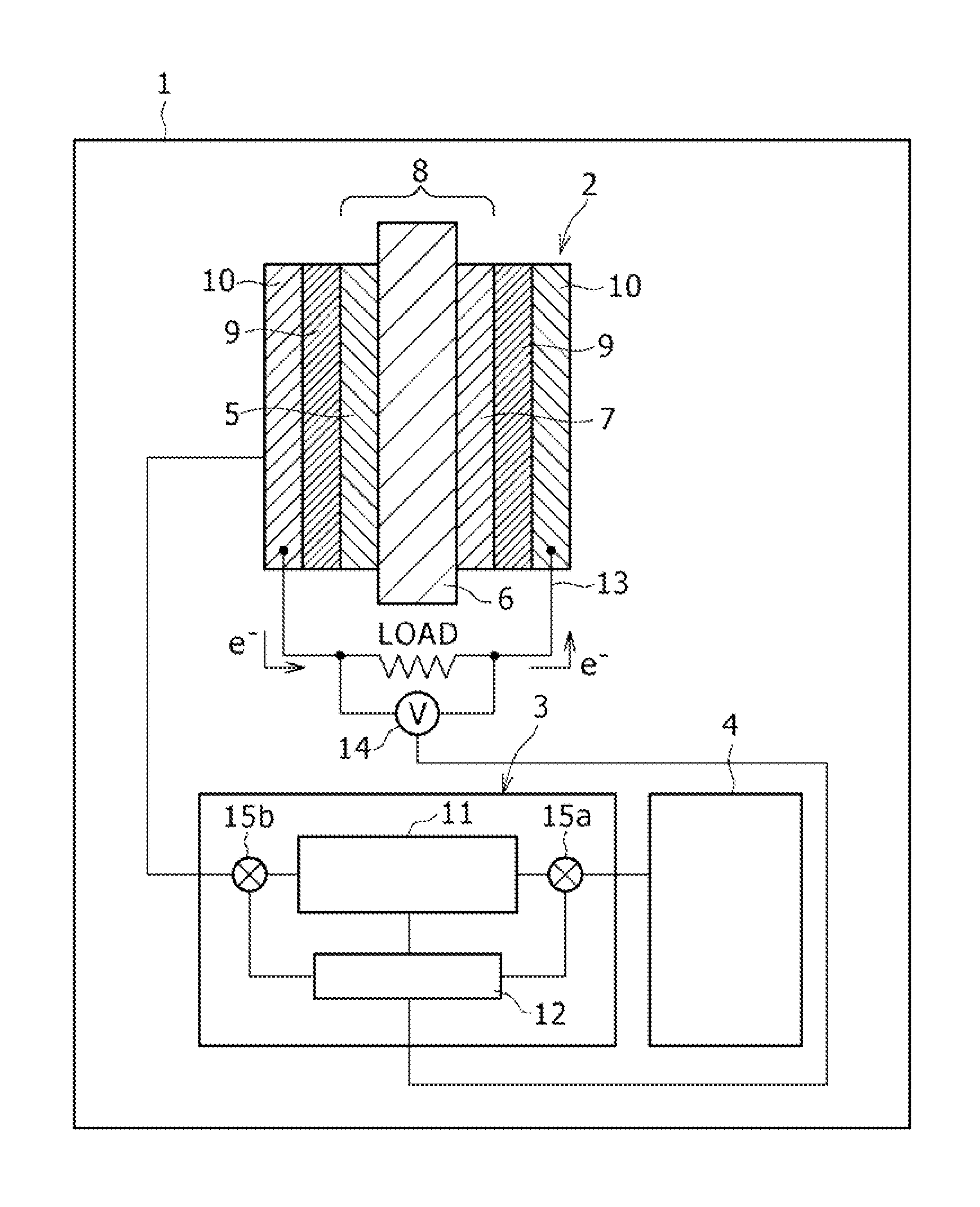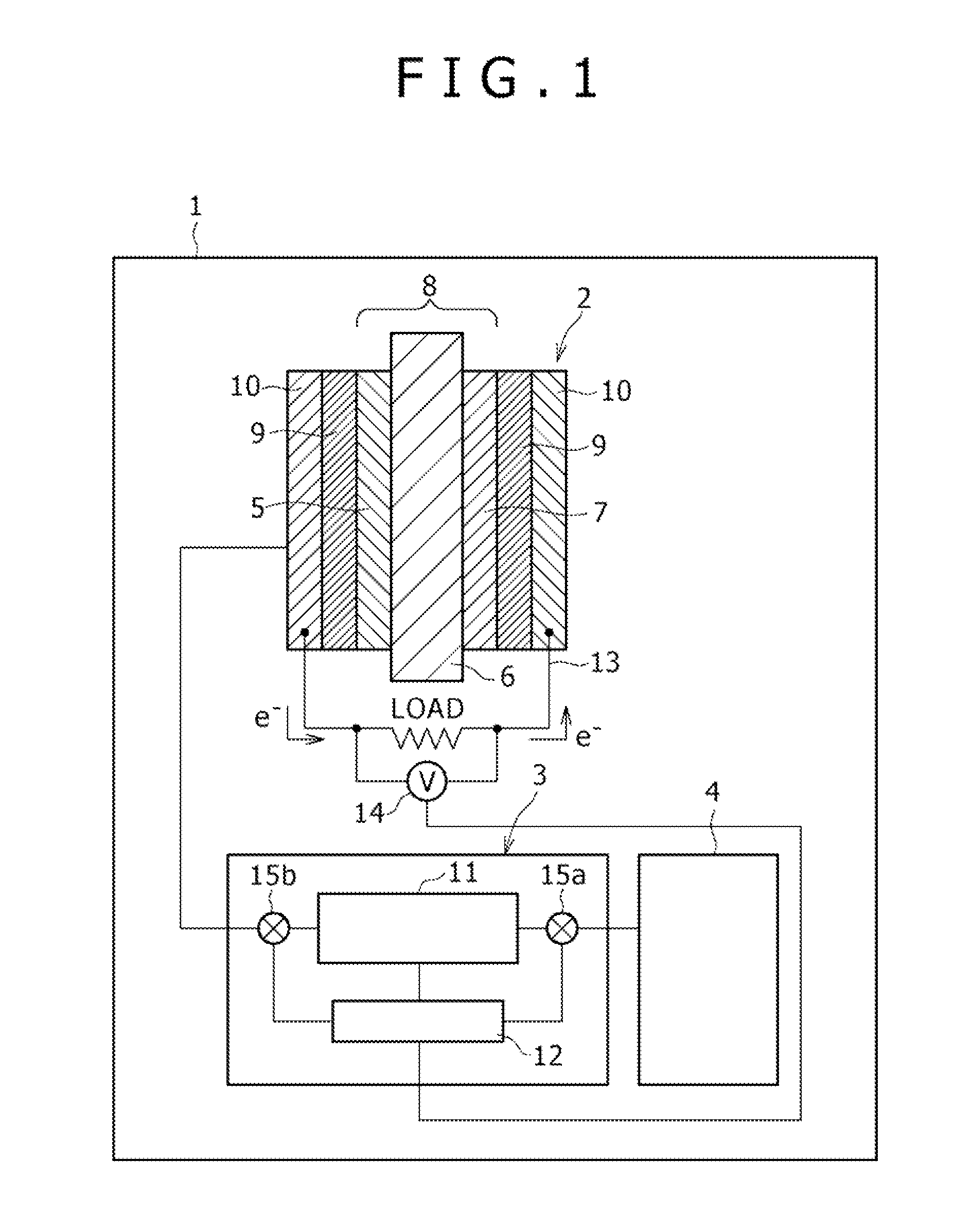Electrochemical Energy Generating Apparatus and Method of Driving the Same
a technology of electrochemical energy and generating apparatus, which is applied in the direction of electrochemical generators, fuel cells, reactant parameters control, etc., can solve the problem of crossover of direct methanol fuel supply type fuel cells, and achieve the effect of reducing fuel crossover, enhancing diffusibility and reactivity of fuel, and increasing energy density
- Summary
- Abstract
- Description
- Claims
- Application Information
AI Technical Summary
Benefits of technology
Problems solved by technology
Method used
Image
Examples
example 1
[0054]As the electrochemical device, a fuel cell 2 as shown in FIG. 1 was fabricated.
[0055]A fuel electrode 5 was prepared by mixing a catalyst, containing Pt and Ru in a predetermined ratio, with a dispersion of Nafion (registered trademark) in a predetermined ratio. In addition, an air electrode 7 was prepared by a catalyst, having Pt carried on carbon powder, with a dispersion of Nafion in a predetermined ratio.
[0056]Next, the fuel electrode 5 and the air electrode 7 prepared as above were hot pressed together with an about 90 μm-thick polymer solid electrolyte membrane (Nafion 1135 (registered trademark), a product by du Pont) under the conditions of 150° C. and 0.2 kN for 10 min, to prepare an MEA 8.
[0057]The MEA 8 was sandwiched by a 280 μm-thick carbon paper (product code: HGP-H-090, a product by Toray Industries, Inc.) and a titanium mesh, to fabricate the fuel cell 2. Here, the carbon paper corresponds to the diffusion layer 9, and the titanium mesh corresponds to the curre...
example 2
[0061]A fuel cell system 1 was fabricated in the same manner as in Example 1, except that the same total amount (50 μl) of methanol as used in Example 1 was supplied to the filter paper at a time, without controlling the amount of methanol supplied to the filter paper (fuel evaporating section 11) by utilizing a syringe, as shown in FIG. 3.
[0062]Incidentally, in Examples 1 and 2, only the evaporated methanol was supplied to the fuel electrode 5, and the water necessary for consumption of methanol was not supplied to the fuel cell 5 at all.
[0063]Then, characteristics of the fuel cell systems fabricated in Examples 1 and 2 were evaluated.
[0064]The fuel cell was connected to an electrochemical measuring instrument (product name: MULTISTAT 1480, a product by Solartron), a control was made such that the current flowing in the fuel cell would be constant (100 mA), and the cell voltage of the fuel cell was serially read. The results are collectively shown in FIG. 4.
example 3
[0073]A fuel cell system 1 was fabricated in the same manner as in Example 1, except that the system was so configured that methanol (20 μl) was supplied in a gaseous state.
PUM
| Property | Measurement | Unit |
|---|---|---|
| electrochemical energy | aaaaa | aaaaa |
| energy density | aaaaa | aaaaa |
| operating temperatures | aaaaa | aaaaa |
Abstract
Description
Claims
Application Information
 Login to View More
Login to View More - R&D
- Intellectual Property
- Life Sciences
- Materials
- Tech Scout
- Unparalleled Data Quality
- Higher Quality Content
- 60% Fewer Hallucinations
Browse by: Latest US Patents, China's latest patents, Technical Efficacy Thesaurus, Application Domain, Technology Topic, Popular Technical Reports.
© 2025 PatSnap. All rights reserved.Legal|Privacy policy|Modern Slavery Act Transparency Statement|Sitemap|About US| Contact US: help@patsnap.com



